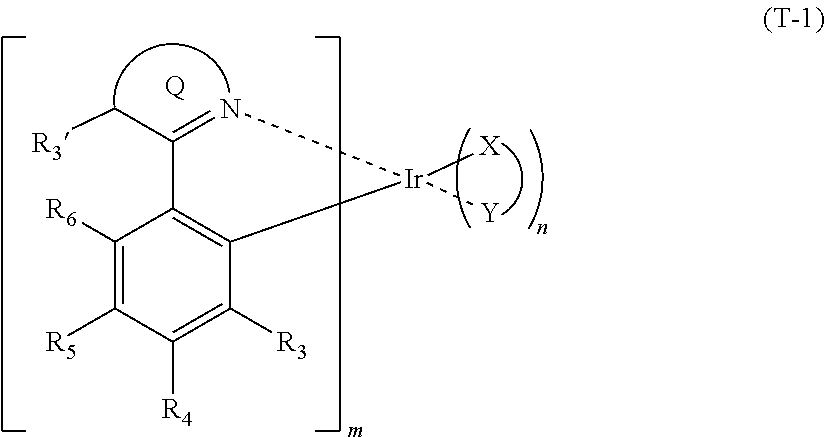Organic electroluminescence device
a technology of electroluminescence device and organic material, which is applied in the direction of discharge tube/lamp details, luminescent compositions, discharge tube luminescnet screens, etc., can solve the problems of unfavorable device durability, unstable oxidized species having carbazolyl groups, and shifts in chromaticity, so as to achieve excellent durability, low power consumption, and high external quantum efficiency
- Summary
- Abstract
- Description
- Claims
- Application Information
AI Technical Summary
Benefits of technology
Problems solved by technology
Method used
Image
Examples
synthesis example 1
[0252]Exemplified Compound TM-1 and TM-13 shown hereafter is synthesized according to the method described in EXAMPLE 1 and EXAMPLE 13, respectively of U.S. Pat. No. 7,279,232.
example 1
[0253]An indium tin oxide (ITO) film-coated glass substrate having an area of 2.5 square centimeters and a thickness of 0.5 mm (made by GEOMATEC Corporation, surface resistivity: 10 Ω / sq) is placed in a cleaning vessel and subjected to ultrasonic cleaning in 2-propanol, and the thus cleaned substrate is further subjected to UV-ozone treatment of 30 minutes. Onto this transparent anode (ITO film), the following organic layers are evaporated in sequence by use of a vacuum evaporation method.
First layer: ITO / CuPc (copper phthalocyanine), Thickness: 10 nm
Second layer: NPD (N,N′-di-α-naphthyl-N,N′-diphenyl)-benzidine, Thickness: 30 nm
Third layer: Dopant (5% by mass), Host material (95% by mass), Thickness: 30 nm
Fourth layer: BAlq, Thickness: 10 nm
Fifth layer: Alq (tris(8-hydroxyquinoline)aluminum complex, Thickness: 40 nm
[0254]Onto this layer, 0.2 nm-thick film of lithium fluoride and 70 nm-thick film of metal aluminum are evaporated in the order of mention, thereby forming a cathode.
[02...
PUM
| Property | Measurement | Unit |
|---|---|---|
| temperatures | aaaaa | aaaaa |
| energy | aaaaa | aaaaa |
| energy | aaaaa | aaaaa |
Abstract
Description
Claims
Application Information
 Login to View More
Login to View More - R&D
- Intellectual Property
- Life Sciences
- Materials
- Tech Scout
- Unparalleled Data Quality
- Higher Quality Content
- 60% Fewer Hallucinations
Browse by: Latest US Patents, China's latest patents, Technical Efficacy Thesaurus, Application Domain, Technology Topic, Popular Technical Reports.
© 2025 PatSnap. All rights reserved.Legal|Privacy policy|Modern Slavery Act Transparency Statement|Sitemap|About US| Contact US: help@patsnap.com



